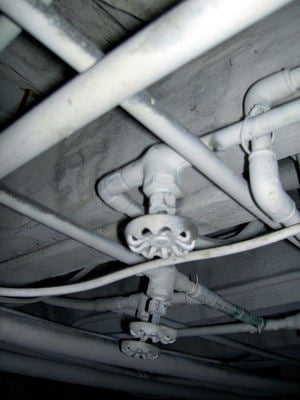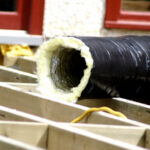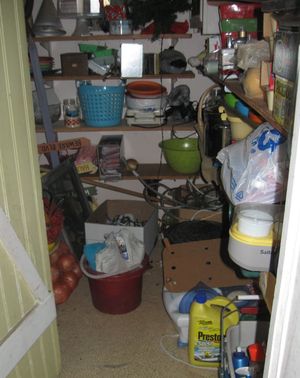Basements can be challenging rooms to decorate, especially if the ceiling is left unfinished. Basement ceilings are difficult to work with as there are often pipes, wires, ductwork and supports left exposed which cannot be moved. You may feel that you have no option but to look at your unattractive basement ceiling indefinitely, but nothing could be further from the truth. Consider any of these 5 ways to disguise a basement ceiling.
How to disguise a basement ceiling – Painting
The absolute easiest way to cover a basement ceiling is with paint. Painting a basement ceiling will also be your least expensive option and the quickest solution. By painting the entire basement ceiling one consistent color, you will camouflage its unpleasant look and draw attention away from unsightly pipes, ductwork and supports.
There are two options when painting a basement ceiling. A dark color will conceal things better, but it will darken the room. A light color will brighten a basement, but doesn’t camouflage as well. Neither option is better than the other, and they will both make the room look better. For best results, purchase or rent a paint sprayer to evenly coat the surface area.
One additional tip is to be sure that you paint basement walls a different color than the ceiling itself, as this will help pull away attention away from the basement ceiling. If you’ve opted to paint the basement ceiling a dark color, select a light color for the walls. A darker tone will look best on the walls if you’ve used a light color on the ceiling.
How to disguise a basement ceiling – Drywall
Drywall can be used to cover a basement ceiling, and it will create an even surface that can be painted smoothly. With drywall you aren’t so much disguising the ceiling as you are entirely covering it and giving the room a finished look. The down side of using drywall to cover a basement ceiling, is that if you need to access pipes or ductwork, the drywall will have to be cut into.
There is quite a bit of work involved by using drywall, as you will likely have to relocate pipes and wires, or box them in. Before you begin this project, you’ll want to consult with a professional contractor to discuss which elements can be moved and which should be worked around.
How to disguise a basement ceiling – Mirrors
Basement ceilings sit much lower than that of an average ceiling, which can make a room feel small and dark. One way to cover a basement ceiling is with the use of mirrors. Installing a mirrored ceiling can be a little tricky, and somewhat expensive, but it will help in making the room appear more spacious. Again, this option will not so much disguise a basement ceiling, but will cover it completely giving the room a finished look.
How to disguise a basement ceiling – Drop ceilings
A drop ceiling is a cost effective, low-maintenance option for covering a basement ceiling. The best thing about using a drop ceiling in the basement, is that it completely covers unsightly pipes and ductwork, but you can still have easy access to them in the event of an emergency. Drop ceilings (also called suspended ceilings) consist of framework that hangs on wires attached to the joists. The framework sits underneath pipes and ductwork, so moving them is not necessary.
Another benefit of using drop ceilings to cover basement ceilings, is that they are terrific sound absorbers. Made up of fibers, drop ceilings have the benefit of blocking sound from upstairs rooms, as well as reducing noise within the basement from carrying on to other areas of the house.
How to disguise a basement ceiling – Fabric
A ceiling treatment made of fabric is another fairly inexpensive method used to cover a basement ceiling. Obviously, a fabric ceiling isn’t the most manly choice of all, but it will look attractive and work quite effectively. There are hundreds upon hundreds of fabric prints and colors to choose from, which can then be stapled to the ceiling with a staple gun. The fabric will look nice and cover unsightly pipes, wires, and ductwork, without blocking access to them in the event of an emergency.
** To read more from this author, CLICK HERE.
SOURCE:
Personal knowledge and experience







